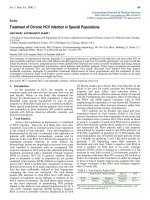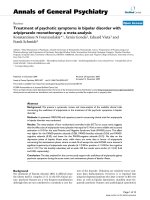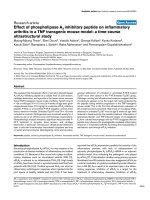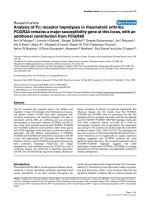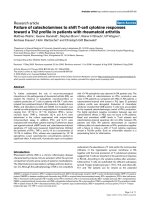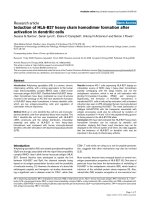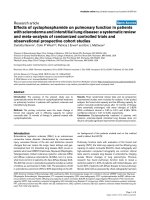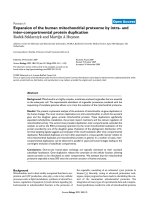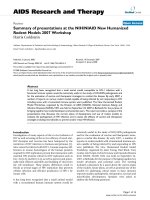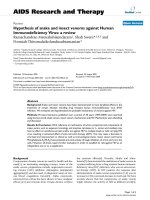Báo cáo y học: " Exacerbations of chronic obstructive pulmonary disease: When are antibiotics indicated? A systematic review" ppsx
Bạn đang xem bản rút gọn của tài liệu. Xem và tải ngay bản đầy đủ của tài liệu tại đây (165.43 KB, 3 trang )
BioMed Central
Page 1 of 3
(page number not for citation purposes)
Respiratory Research
Open Access
Correction
Exacerbations of chronic obstructive pulmonary disease: When are
antibiotics indicated? A systematic review
Milo A Puhan*, Daniela Vollenweider, Tsogyal Latshang, Johann Steurer and
Claudia Steurer-Stey
Address: Horten Centre, University Hospital of Zurich, Postfach Nord, CH-8091 Zurich, Switzerland
Email: Milo A Puhan* - ; Daniela Vollenweider - ; Tsogyal Latshang - ;
Johann Steurer - ; Claudia Steurer-Stey -
* Corresponding author
See related research article by Puhan et al., />Correction
Since publication of our article [1], we have been made
aware of an error in our article.
We have transposed the proportion of patients with treat-
ment failure in the antibiotic and placebo groups of one
trial [2]. 19 out of 57 patients experienced a treatment fail-
ure compared to 28 out of 59 patients in the placebo
group (odds ratio 0.55 (0.26–1.17).
In the results section of the abstract the sentences "For the
effects of antibiotics on treatment failure there was much
heterogeneity across all trials (I
2
= 82%). Meta-regression
revealed severity of exacerbation as significant explana-
tion for this heterogeneity (p = 0.016): Antibiotics did not
reduce treatment failures in outpatients with mild to
moderate exacerbations (pooled odds ratio 1.09, 95% CI
0.75–1.59, I
2
= 18%)" the text should read: "For the effects
of antibiotics on treatment failure there was much hetero-
geneity across all trials (I
2
= 75%). Meta-regression
revealed severity of exacerbation as significant explana-
tion for this heterogeneity (p = 0.038): Antibiotics did not
reduce treatment failures in outpatients with mild to
moderate exacerbations (pooled odds ratio 0.81, 95% CI
0.55–1.18, I
2
= 13%)."
In the results section, following the subheading "Effects of
antibiotics" the second paragraph "Figure 2 shows that the
effects of antibiotics were very heterogeneous across trials
(I
2
= 82%). When we explored predefined sources of het-
erogeneity in meta-regression analyses we found that gen-
eration of antibiotic (p = 0.55), definition of outcomes (p
= 0.20), length of follow-up (p = 0.38) and study quality
(p = 0.92) did not explain heterogeneity." should read
"Figure 2 shows that the effects of antibiotics were very
heterogeneous across trials (I
2
= 75%). When we explored
predefined sources of heterogeneity in meta-regression
analyses we found that generation of antibiotic (p = 0.59),
definition of outcomes (p = 0.06), length of follow-up (p
= 0.85) and study quality (p = 0.42) did not explain het-
erogeneity."
In the results section, following the subheading "Effects of
antibiotics" the fourth paragraph "When we did the meta-
analysis without this trial, we found that severity of exac-
erbations was associated significantly with treatment
effects (p = 0.016). Figure three shows the pooled results
separately for trials including patients with mild to mod-
erate exacerbations and patients with severe exacerba-
tions. For mild to moderate exacerbations, antibiotics did
not significantly reduce the risk for treatment failure (OR
1.09, 95% CI 0.75–1.59, I
2
= 18%). When the Allegra trial
[25] was included in the meta-analysis the pooled esti-
mate favoured antibiotics (OR 0.55, 95% CI 0.41–0.74,
with a number-needed to treat of 9, 95% CI 6–16) but
there was a large amount of heterogeneity (I
2
= 87%)."
should read "When we did the meta-analysis without this
trial, we found that severity of exacerbations was associ-
Published: 15 December 2008
Respiratory Research 2008, 9:81 doi:10.1186/1465-9921-9-81
Received: 2 July 2008
Accepted: 15 December 2008
This article is available from: />© 2008 Puhan et al; licensee BioMed Central Ltd.
This is an Open Access article distributed under the terms of the Creative Commons Attribution License ( />),
which permits unrestricted use, distribution, and reproduction in any medium, provided the original work is properly cited.
Respiratory Research 2008, 9:81 />Page 2 of 3
(page number not for citation purposes)
Forest plot showing nine studies grouped according to severity of exacerbationFigure 2
Forest plot showing nine studies grouped according to severity of exacerbation. One study with a substantially
higher treatment failure rate and a short follow-up of five days was not considered in the analysis. The upper five studies
included patients with mild to moderate exacerbations and the four studies below included patients with severe exacerbations.
The x-axis represents the odds ratio for treatment failure. An odds ratio below 1 represents a lower chance of treatment fail-
ure with antibiotics. Studies not reporting treatment failures could not be included in the meta-analysis.
0.01 0.1 1 10
Favours
antibiotics
Favours
placebo
Odds ratio (95% CI)
0.97 (0.23-4.18)Elmes 1957
4/42 4/41
0.08 (0.00-1.47)Berry 1960
0/26 5/27
0.55 (0.26-1.17)Anthonisen 1987 19/57 28/59
1.05 (0.64-1.72)Jorgensen 1992
49/132 49/136
1.06 (0.18-6.30)Sachs 1995
4/40 2/21
0.13 (0.02-0.66)Pines 1968
5/15 12/15
0.31 (0.18-0.52)Pines 1972
58/176 53/86
0.27 (0.07-1.04)Alonso Martinez 1992
4/61 6/29
0.13 (0.03-0.48)Nouira 2001
3/47 16/46
Study Odds ratio (95% CI)
(Fixed-effects Models)
Treatment failures
(No of Events/Total No)
Antibiotics Placebo
Test for heterogeneity χ
2
=4.61, I
2
=13%, p=0.33
Test for heterogeneity χ
2
=2.22, I
2
=0%, p=0.53
0.81 (0.55-1.18)Overall (95% CI)
85/299 79/282
0.25 (0.16-0.39)Overall (95% CI)
70/299 87/176
Forest plot showing ten studies that compared the effects of antibiotics and placebo on treatment failure. The x-axis repre-sents the odds ratio for treatment failureFigure 1
Forest plot showing ten studies that compared the effects of antibiotics and placebo on treatment failure. The
x-axis represents the odds ratio for treatment failure. An odds ratio below 1 represents a lower chance of treatment
failure with antibiotics. Studies not reporting treatment failures could not be included in the meta-analysis.
Favours
antibiotics
Favours
placebo
Test for heterogeneity χ
2
=36.39, I
2
=75%, p<0.001
Odds ratio (95% CI)
0.01
0.1 1 10
Study Odds ratio (95% CI)Treatment failures
(No of Events/Total No)
Antibiotics Placebo
0.97 (0.23-4.18)Elmes 1957
4/42 4/41
0.08 (0.00-1.47)Berry 1960 0/26 5/27
0.13 (0.02-0.66)Pines 1968
5/15 12/15
0.31 (0.18-0.52)Pines 1972 58/176 53/86
0.55 (0.26-1.17)Anthonisen 1987
19/57 28/59
0.16 (0.09-0.27)Allegra 1991
24/176 79/159
0.27 (0.07-1.04)Alonso Martinez 1992 4/61 6/29
1.05 (0.64-1.72)Jorgensen 1992 49/132 49/136
1.06 (0.18-6.30)Sachs 1995 4/40 2/21
0.13 (0.03-0.48)Nouira 2001 3/47 16/46
Publish with BioMed Central and every
scientist can read your work free of charge
"BioMed Central will be the most significant development for
disseminating the results of biomedical research in our lifetime."
Sir Paul Nurse, Cancer Research UK
Your research papers will be:
available free of charge to the entire biomedical community
peer reviewed and published immediately upon acceptance
cited in PubMed and archived on PubMed Central
yours — you keep the copyright
Submit your manuscript here:
/>BioMedcentral
Respiratory Research 2008, 9:81 />Page 3 of 3
(page number not for citation purposes)
ated significantly with treatment effects (p = 0.038). Fig-
ure three shows the pooled results separately for trials
including patients with mild to moderate exacerbations
and patients with severe exacerbations. For mild to mod-
erate exacerbations, antibiotics did not significantly
reduce the risk for treatment failure (OR 0.81, 95% CI
0.55–1.18, I
2
= 1 three%). When the Allegra trial [25] was
included in the meta-analysis the pooled estimate
favoured antibiotics (OR 0.45, 95% CI 0.34–0.61, with a
number-needed to treat of 9, 95% CI 7–12) but there was
a large amount of heterogeneity (I
2
= 83%)."
The corrected versions of Figures two and three are given
here- see figures 1 and 2.
We apologize for any inconvenience or confusion that
this may have caused.
References
1. Puhan MA, Vollenweider D, Latshang T, Steurer J, Steurer-Stey C:
Exacerbations of chronic obstructive pulmonary disease:
when are antibiotics indicated? A systematic review. Respira-
tory research 2007, 8:30.
2. Anthonisen NR, Manfreda J, Warren CP, Hershfield ES, Harding GK,
Nelson NA: Antibiotic therapy in exacerbations of chronic
obstructive pulmonary disease. Annals of Internal Medicine 1987,
106(2):196-204.
